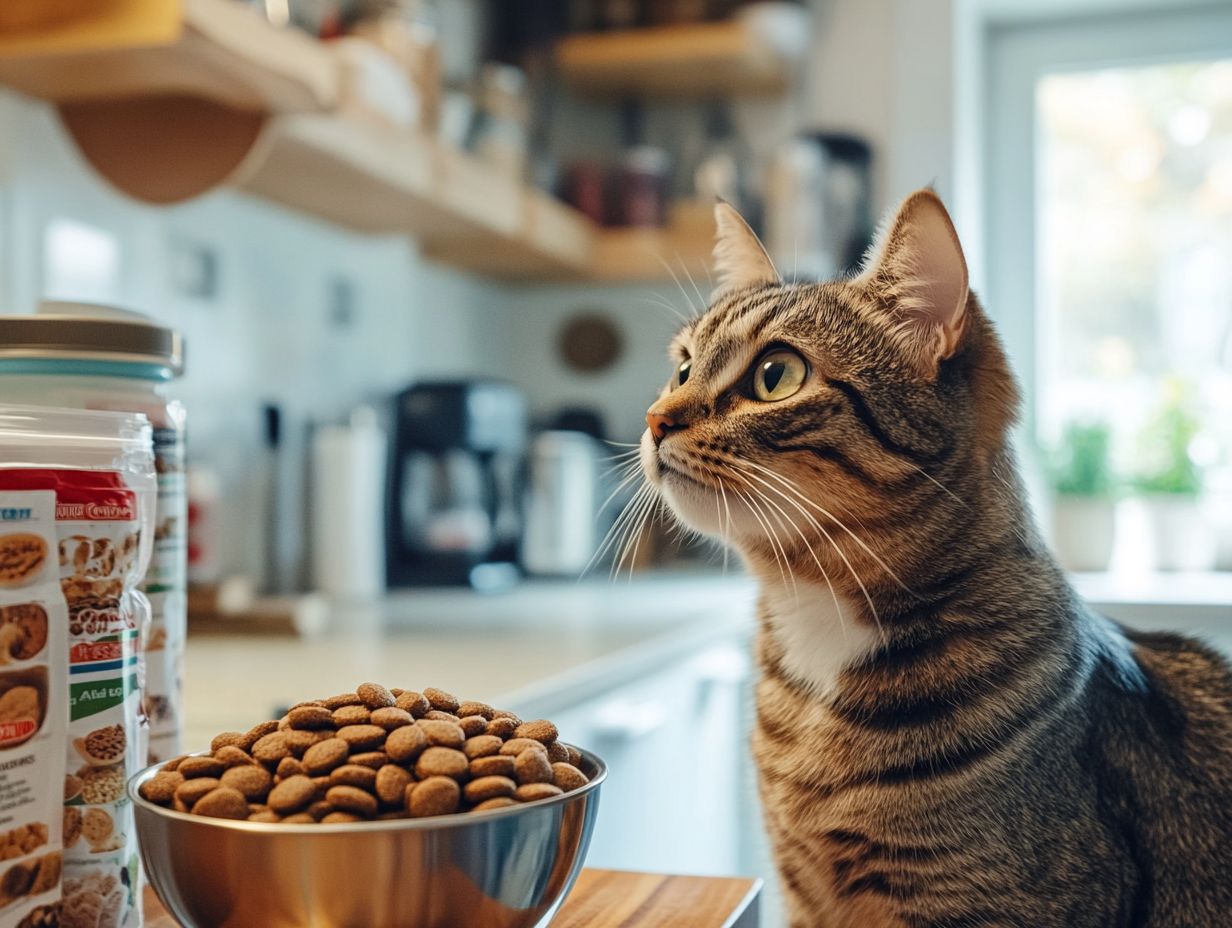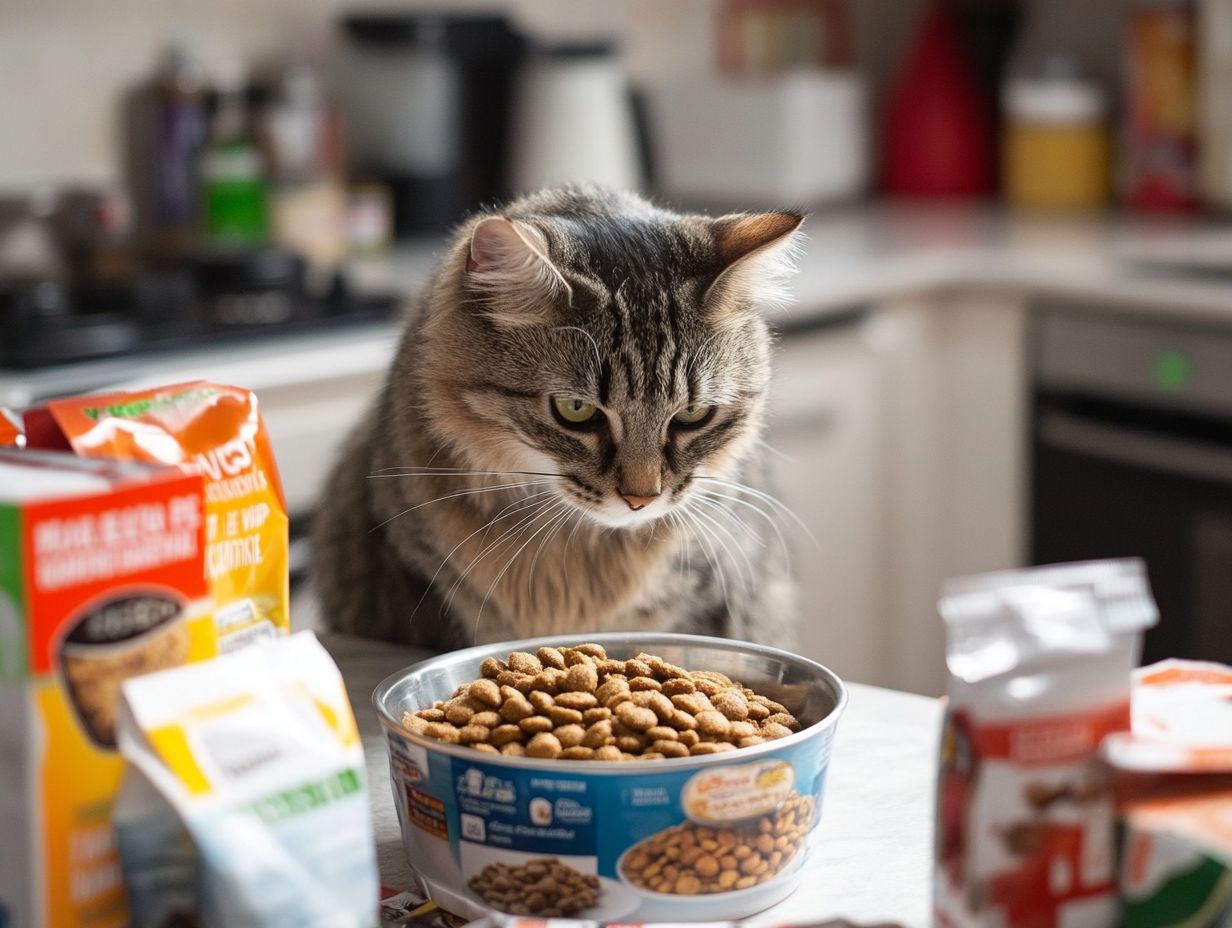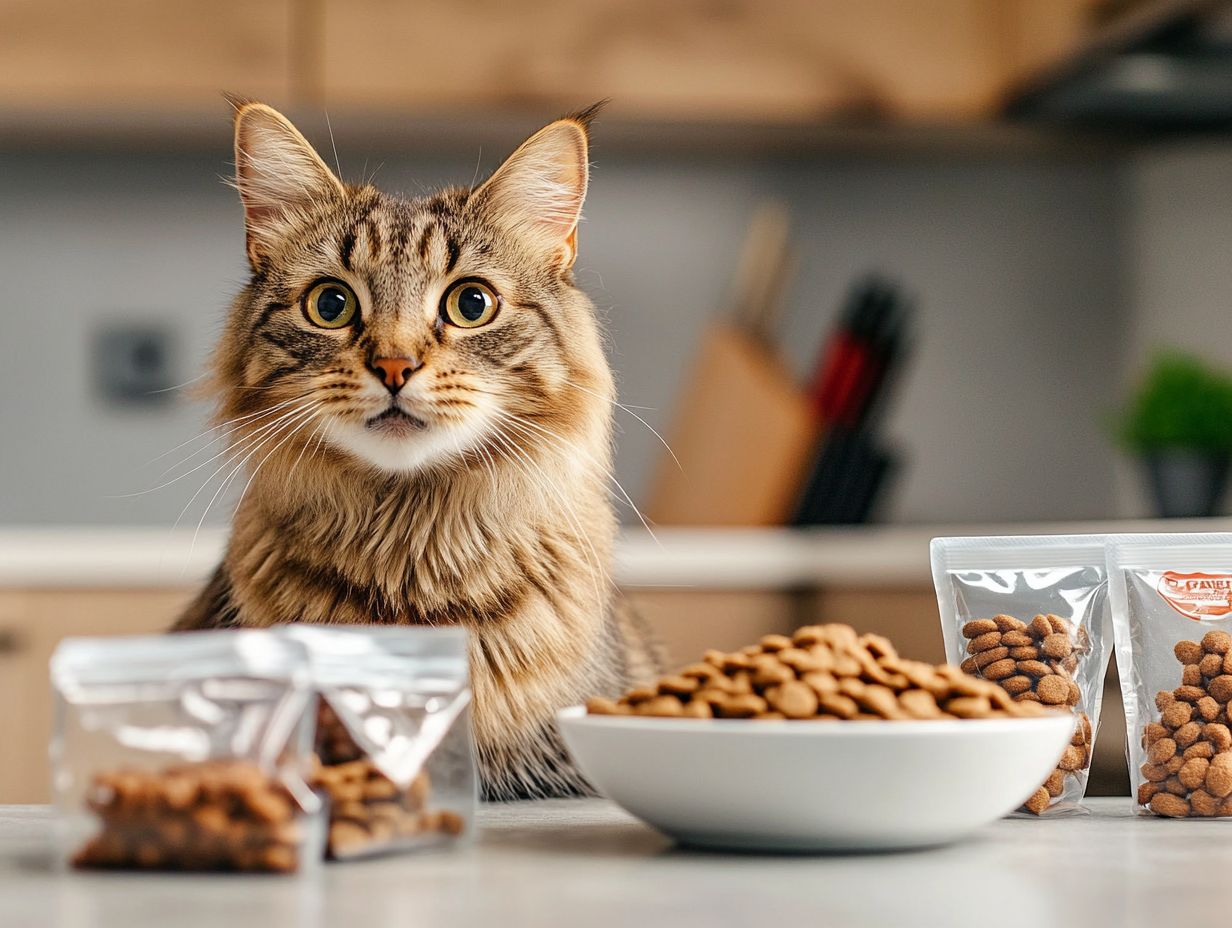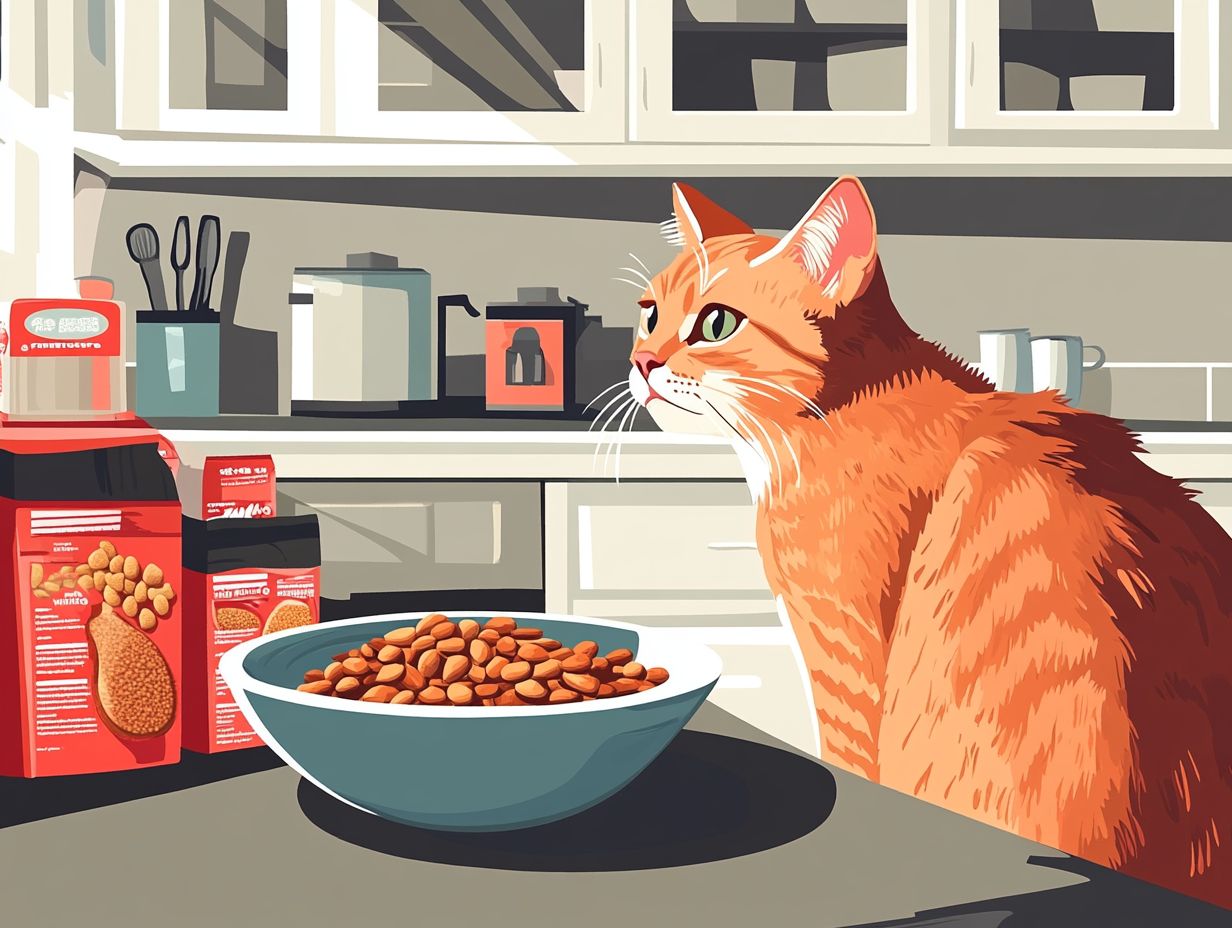As obligate carnivores, cats require a diet rich in animal-source proteins for optimal health. While grain-free cat food has gained popularity among pet owners seeking to provide their felines with a more natural diet, it is crucial to prioritize high-quality protein sources over grains, in line with veterinary nutritional standards. This trend mirrors hypoallergenic diets often considered for food sensitivities and allergies.
This trend has sparked important conversations about its safety, nutritional adequacy, and the potential for taurine deficiency, which is vital for heart health in cats.
We explore what grain-free cat food is, its rising appeal—supported by recent statistics showing a significant increase in interest among cat owners—and the concerns surrounding it, including potential links to serious health issues.
Additionally, we discuss the latest research, including findings from veterinary researchers, and how to choose the best options for your furry friend. Always consult with a veterinarian before making significant dietary changes, particularly regarding grain-free, raw, or homemade diets.
Key Takeaways:

What Is Grain-Free Cat Food?
Grain-free cat food refers to pet food formulations that exclude traditional grain ingredients, such as wheat and corn, which are often linked to food allergies and sensitivities in cats. This type of diet has gained popularity among pet owners who are concerned about their cats’ health, particularly those with specific dietary needs or sensitivities. However, it is essential to ensure that such diets provide the necessary animal-source proteins.
The trend toward grain-free cat food parallels a similar shift among owners of other companion animals, especially dogs. As the pet food market has moved away from traditional meat and grain-based diets in favor of more premium grain-free options, suppliers have responded by developing these formulations for both dogs and cats.
Why Is Grain-Free Cat Food Popular?
The popularity of grain-free cat food has surged in recent years, with studies indicating a notable increase in consumer interest. This trend is fueled by pet owners’ growing awareness of dietary management and the potential health benefits associated with these diets. Many consumers are opting for grain-free options due to concerns about food allergies and sensitivities, believing that such choices can enhance their cats’ health and overall well-being.
Furthermore, this trend is bolstered by an increasing focus on ecological sustainability within the pet food industry, which encourages the use of healthier ingredients and may lead to more affordable pet food prices. However, the primary focus should remain on the cat’s health and nutritional needs.
What Are the Concerns About Grain-Free Cat Food?
Grain-free cat food has gained significant popularity; however, several concerns persist within the veterinary community, particularly regarding its potential link to canine heart disease, specifically diet-related dilated cardiomyopathy (DCM). Veterinary researchers and cardiologists investigating the relationship between DCM and certain diets have observed that some grain-free diets may lead to taurine deficiency, an amino acid crucial for heart health.
This raises questions about the nutritional adequacy of these pet foods. Pet owners striving to meet their animals’ nutritional needs must consider the health risks associated with such diets, including recognizing symptoms of heart issues and the importance of regular veterinary check-ups, especially for breeds identified as at risk.
1. Link to Canine Dilated Cardiomyopathy (DCM)
Recent studies have focused on the association between grain-free diets and canine dilated cardiomyopathy (DCM), drawing the attention of veterinary researchers and cardiologists who seek to determine how nutrition impacts heart health across various dog breeds, including Golden Retrievers and Doberman Pinschers, as well as Great Danes and Boxers.
Concerns have arisen regarding the high concentrations of dietary pulses in some grain-free foods, which may contribute to this serious heart condition characterized by heart failure and other health issues. Numerous studies, particularly a comprehensive investigation published by the FDA, are examining the links between grain-free diets and increased incidences of DCM among different breeds.
Both veterinarians and pet owners express caution, noting that while grain-free diets may appeal to some due to perceived health benefits, maintaining nutritional balance is crucial. Other breeds, such as Bulldogs and Cocker Spaniels, have also demonstrated susceptibility.
Proper storage of grain-free cat food is essential to ensure safety and avoid spoilage. Store the food in a cool, dry place, and always check for signs of spoilage, such as an off smell or discoloration.
Conclusion
In conclusion, when choosing cat food, it is vital to understand your individual cat’s needs based on life stage, health conditions, and veterinary recommendations. Adopting best practices will ensure your feline friend stays healthy, happy, and well-nourished.
Disclaimer: Cat owners should always consult their veterinarians when considering dietary changes, especially for conditions like kidney disease or diabetes. Proper nutrition is crucial for cats as obligate carnivores; they rely heavily on animal-source proteins. Inadequate diets can lead to serious health issues.
Insights from veterinary cardiology highlight the need for further exploration of ingredient sources and formulations, as dietary choices can significantly impact overall pet health and lifespan.
2. Lack of Nutrients
One of the primary concerns regarding grain-free cat food is that it may lack essential nutrients, particularly taurine, an amino acid vital for normal heart and organ function. Veterinarians emphasize that insufficient taurine—often resulting from poorly formulated diets that do not incorporate a variety of protein sources—can lead to serious health issues in cats, similar to the problems observed in some dogs on grain-free diets. Brands such as Royal Canin and Hill’s Science Diet are known for their formulations that maintain adequate taurine levels, while diets lacking in diverse protein sources may raise red flags.
Taurine is crucial for preventing dilated cardiomyopathy and other heart diseases in cats. Cats have specific dietary needs that must be met to maintain their health, including appropriate levels of protein, vitamins, and minerals. While grain-free options may appeal to some pet owners, they can potentially omit these critical nutrients, leading to deficiencies.
Therefore, veterinary medicine plays a vital role in guiding cat owners in their dietary choices and recommending specific meals that fulfill the unique nutritional requirements of cats.
3. Potential for Contaminants

Another concern regarding grain-free cat food is the potential for contaminants arising from the manufacturing process, which could negatively impact pet health. Research studies in veterinary biomedical sciences have found that some formulations of pet food may be contaminated with harmful ingredients or other substances, raising concerns about the safety of certain grain-free cat foods in the marketplace. Specific brands like Blue Buffalo and Wellness have faced recalls due to contamination issues, underscoring the need for caution.
These studies indicate that ingredients such as mycotoxins, heavy metals, and microbial pathogens could unintentionally contaminate these diets, leading to gastrointestinal symptoms, neurological issues, or even long-term chronic diseases in cats. This underscores the importance of rigorous testing protocols and quality control measures implemented by manufacturers, who bear significant responsibility for ensuring the safety of their products.
As pet owners become more aware of these risks, they may demand greater transparency and accountability from brands, prompting a shift toward formulations that prioritize health without compromising quality, as emphasized by the Pet Food Institute.
What Do Studies Say About Grain-Free Cat Food?
Numerous studies and investigations have explored the effects of grain-free cat food on pet health, prompting the Food and Drug Administration (FDA) to take notice of growing concerns regarding the nutritional adequacy of grain-free diets.
These concerns include potential links to serious health issues, such as diet-related dilated cardiomyopathy (DCM). The research aims to assess how dietary changes in pets affect their health and the implications for veterinary cardiology.
1. FDA Investigation on DCM Cases
The FDA’s investigation into cases of diet-related dilated cardiomyopathy (DCM) has prompted significant scrutiny regarding the safety and nutritional adequacy of grain-free diets for pets. While much of the discussion has historically focused on dogs, it’s essential to recognize that similar considerations apply to cats. Veterinary researchers have contributed valuable insights and data to this investigation, helping to clarify the association between grain-free diets and the rising rates of DCM in certain dog breeds.
Their analysis has uncovered several key findings that suggest a link between grain-free diets high in peas and lentils and an increased risk of this severe heart disease. The researchers have meticulously examined pet food formulations, demonstrating that diets lacking traditional grains may inadvertently lead to deficiencies or imbalances in essential nutrients, which can adversely affect cardiac function.
These findings serve as an important reminder to pet owners about the necessity of providing well-researched and nutritionally complete diets for their pets, as well as the importance of consulting with veterinarians before making significant dietary changes.
2. Studies on Nutritional Adequacy
Research on the nutritional adequacy of grain-free cat food has highlighted key factors that veterinarians believe could impact pet health and dietary management. These studies have examined the components of grain-free cat food diets to determine whether they meet the minimum nutritional requirements for health.
Practical Feeding Advice
Cat owners should learn how to read pet food labels, looking for quality ingredients and ensuring that their cat’s diet is nutritionally complete. It’s also vital to understand appropriate food storage and handling practices to prevent spoilage and contamination. Signs of food spoilage include an off smell, discoloration, or mold.
While ethical and sustainability concerns are important, they should be framed within the context of maintaining feline health. Prioritizing the nutritional needs of cats is crucial when considering these issues.
Summary
In conclusion, cat owners should select diets that are well-researched and nutritionally balanced, recognizing the importance of veterinary guidance in dietary decisions. A balanced diet is essential for maintaining feline health, and understanding the implications of dietary choices is crucial for pet owners.
Well-designed research has shown that while most grain-free cat food diets tend to be higher in protein and fat, they often fall short in providing certain essential nutrients such as taurine, omega-3 fatty acids, and various vitamins. Research indicates that deficiencies in essential nutrients could lead to certain chronic illnesses, like feline dilated cardiomyopathy, skin conditions, and gastrointestinal issues, as well as problems with coat and skin health.
Additionally, fiber may be sourced from other ingredients, and it is crucial to maintain a dietary balance that includes both animal and plant sources for overall health. As pet owners consider grain-free cat food options, it is essential to ensure that a balanced diet is provided to compensate for these deficiencies, thereby promoting their cat’s optimal health and well-being. We encourage readers to consult with their veterinarian before making significant dietary changes, especially regarding grain-free diets and their potential risks and benefits.
3. Research on Contaminants
Research studies on grain-free cat food and its contaminants have revealed significant health risks associated with inadequately regulated practices in the pet food industry. Findings from veterinary biomedical sciences and veterinary researchers have raised alarms about the safety of specific grain-free formulas, highlighting the need for increased scrutiny to ensure compliance with pet food safety regulations and address diet-related dilated cardiomyopathy.
Investigations into the safety of pet food for cats and dogs have uncovered concerning levels of toxic substances, such as heavy metals like lead and arsenic, and mycotoxins like aflatoxin, in certain commercially available grain-free products. These substances can have serious effects on cat health, including an increased risk of kidney disease and life-threatening gastrointestinal issues. This has prompted urgent calls for enhanced regulation by the Food and Drug Administration and monitoring of pet food formulations.
Cats consuming these contaminated foods may face an increased risk of illnesses, including kidney disease and life-threatening gastrointestinal issues. Veterinary experts, including those in veterinary cardiology, emphasize that the health of companion animals cannot be guaranteed without stringent quality control measures in place to prevent issues such as taurine deficiency.
The significance of pet food safety regulations extends beyond direct animal protection; it also fosters and maintains consumer confidence in the industry. Collaboration among manufacturers, researchers, and regulators is essential to achieve these goals.
How to Choose Safe Grain-Free Cat Food and Address Dietary Management?
Selecting safe grain-free cat food necessitates careful consideration of several factors, including the AAFCO label, which signifies that the product meets established nutritional standards for pet health and aligns with nutritional requirements. For more information, you can read about the safety concerns surrounding grain-free diets, including diet-related issues such as DCM-like changes, in this article: Is Grain-Free Cat Food Safe? Addressing Recent Concerns and Studies.
Additionally, pet owners should evaluate the protein sources included in these diets, as the quality and variety of protein are crucial for effectively managing their cats’ health needs, especially to avoid issues like taurine deficiency.
1. Look for AAFCO Label

The AAFCO label is a crucial consideration for pet owners when selecting grain-free cat food, as it indicates the product’s compliance with AAFCO’s standards for meeting the nutritional needs of pets. Understanding the significance of the AAFCO label can help ensure that cats receive balanced nutrition tailored to their specific dietary requirements.
This certification reflects a commitment to high standards and provides pet owners with peace of mind. For instance, a label that adheres to AAFCO’s nutrient profiles guarantees that the food contains essential vitamins and minerals vital for a cat’s well-being.
When examining the label, pet owners should look for terms like “complete and balanced,” as well as specific nutrient measurements such as protein content and fatty acids. These elements not only fulfill immediate dietary needs but also contribute to a cat’s overall vitality and longevity.
In this way, choosing AAFCO-compliant products can promote optimal diets and health for cats.
2. Check for Protein Sources
- Complete and balanced
- Quality protein sources
- Absence of harmful fillers
- Specific nutrient measurements
- Consideration for life stages (kittens, senior cats, pregnant or nursing cats)
Additionally, it’s important to consider the ethical and sustainability aspects of sourcing animal protein, while prioritizing the cat’s health at all times.
High-quality protein sources in grain-free cat food are essential for optimal feline health and effective dietary management. Adequate protein provides the amino acids necessary for both basic and additional bodily functions, including muscle growth and development, immune function, wound healing, endocrine function, and overall energy maintenance. It’s important to monitor calcium levels to ensure balanced nutrition. For optimal health, adult cats typically require a protein content of at least 26%, while kittens may need about 30-35% protein during growth stages.
Quality protein sources in cat food include chicken, turkey, beef, and fish, each offering distinct benefits. For instance, fish is rich in omega-3 fatty acids, which help maintain healthy skin and a shiny coat. Chicken, on the other hand, is a lean protein source that is easily digestible. Alternative protein sources like duck and venison are beneficial for cats with food sensitivities and can be part of hypoallergenic diets. Given that cats are obligate carnivores, a high proportion of their protein intake should come from animal sources.
A diverse range of protein sources in grain-free cat food ensures a well-rounded nutrient profile, supporting dietary management and promoting long-term health.
3. Consider Your Cat’s Health and Needs
When selecting grain-free cat food, it is essential to consider your cat’s unique health status and dietary needs, as individual health concerns may require different nutritional approaches. For conditions like kidney disease, a lower protein diet may be necessary, while diabetic cats may benefit from high protein and low carbohydrate formulations.
Consulting with a veterinary practitioner or veterinary cardiologist can provide valuable recommendations regarding food sensitivities and ensure that the diet aligns with your cat’s overall health. It’s important to recognize that no two cats are alike; each may have specific conditions such as allergies, kidney disease, or obesity that necessitate special dietary considerations, including monitoring for diet-related dilated cardiomyopathy.
These health issues can significantly influence the types of nutrients needed and those that should be limited. For instance, cats with food allergies require formulations that exclude their specific allergens, while cats with kidney problems typically benefit from a lower protein diet, and those with heart conditions may need adjustments in pulse ingredients.
Alternatives to Grain-Free Cat Food
Pet owners looking for alternatives to grain-free cat food can consider limited ingredient diets, raw diets, and high-quality grain-inclusive cat food. Each of these options can provide balanced nutrition while addressing specific dietary needs.
These alternatives are suitable for pets with food sensitivities and promote a comprehensive approach to dietary management and overall pet health.
1. Limited Ingredient Diet
A limited ingredient diet is an excellent alternative for cats with food sensitivities, as it contains fewer ingredients, making it easier to identify those that may cause allergies. This approach can effectively meet dietary needs and promote overall pet health.
By reducing the number of ingredients, such diets allow pet owners to closely monitor and manage what their cats consume, thereby minimizing the risk of adverse reactions. These diets typically feature a single source of protein and a limited selection of carbohydrates, which lessens the digestive burden and simplifies the identification of problematic ingredients.
As a result, many cats experience a reduction in gastrointestinal issues and skin lesions, reflecting an improvement in their overall well-being. Consequently, sensitivity diets often enhance appetite and energy levels, leading to an improved quality of life for sensitive cats.
2. Raw or Homemade Diet
Raw or homemade diets enable pet owners to have greater control over their cat’s nutritional intake by using high-quality protein sources and fresh ingredients to make individual dietary adjustments. While this approach can enhance pet health, it must be executed carefully to ensure nutritional adequacy and safety. Specific risks like potential bacterial contamination must be addressed, and it’s crucial to consult with a veterinarian to avoid nutritional imbalances.
Cats are obligate carnivores that require a diet rich in animal-based proteins, and a well-constructed homemade diet can help meet these basic needs, as well as any specific health requirements. Pet owners must ensure that these diets are properly balanced with all essential nutrients, including taurine, fatty acids, and vitamins, to prevent deficiencies.
Additionally, adequate food preparation safety measures should be taken, such as proper cooking temperatures and signs of spoilage, to reduce the risks of bacterial contamination; however, with regular guidance from a veterinarian or pet nutritionist, these concerns can be effectively managed. With proper diet planning, owners can adequately support their cat’s health and potentially manage health issues more successfully.
3. High-Quality Grain-Inclusive Cat Food

High-quality grain-inclusive cat food can provide essential nutrients while addressing specific dietary management needs, presenting a suitable alternative for pet owners concerned about the safety of grain-free diets. While these diets can be nutritious, it’s crucial to ensure they still prioritize animal-source proteins to meet the obligate carnivore needs of cats. These formulations are designed to meet the nutritional requirements of cats, ensuring comprehensive support for their overall health.
Plus providing vital proteins and fats, grain-inclusive diets typically include a balanced mix of whole grains, such as brown rice and oatmeal, which aid digestion and offer a steady energy source. However, the carbohydrate content should not exceed the dietary needs of felines, as excess carbohydrates can lead to health issues.
For cats needing weight management or dietary adjustments due to medical conditions, grain-inclusive formulations can be beneficial. The intentional inclusion of fiber can help promote regular bowel movements, while certain grains contribute to healthy skin and coat conditions.
Many of these formulations also cater to age-specific needs, supporting adequate growth in young cats and maintaining health in senior cats, allowing grain-inclusive diets to provide a more holistic approach to their nutritional needs.
Frequently Asked Questions
Is Grain-Free Cat Food Safe? Consult your veterinarian for personalized dietary advice.
The safety of grain-free cat food has been a hot topic in recent years, with concerns raised by some pet owners and studies conducted by experts, including veterinary researchers and organizations like the Pet Food Institute.
What are the concerns surrounding grain-free cat food?
Some pet owners have expressed concerns that grain-free cat food may not provide a balanced and complete diet for their cats due to the absence of grains as a source of carbohydrates. It’s important to ensure that any diet maintains a proper amino acid profile to support overall cat health. These concerns are heightened by the potential impact on amino acid balance.
Are there any studies on the safety of grain-free cat food?
Yes, there have been several studies conducted on the safety and potential health risks of grain-free cat food. Several studies, including those published in veterinary journals, have examined the safety and potential health risks associated with grain-free cat food. These studies have looked into the effects of grain-free diets on cats’ heart health, weight, and overall wellbeing, and have highlighted concerns such as the high concentrations of pulses in grain-free diets affecting heart murmur development.
What have these studies found?
While some studies, including those by veterinary researchers, have shown potential risks associated with grain-free diets, such as an increased risk of diet-related dilated cardiomyopathy (DCM), the results are still inconclusive. More research is needed to fully understand the effects of grain-free cat food and its implications on pet health.
Should I be concerned about feeding my cat grain-free food, considering potential heart health risks?
If you are currently feeding your cat a grain-free diet, it is important to monitor their health, including checking for any signs of heart murmur or other heart-related issues, and consult with your veterinarian or a veterinary cardiologist regularly. However, if you are considering switching to a grain-free diet, it is best to consult with your vet and consider the dietary management options, including nutritional needs and potential food allergies, before making a decision.
What are some safe alternatives to grain-free cat food that meet nutritional requirements?
If you are concerned about the safety of grain-free cat food, you can opt for diets that incorporate whole grains, traditional diets, or other sources of carbohydrates, such as sweet potatoes or legumes. It is important to ensure that your cat’s diet is balanced with adequate protein sources and meets their nutritional requirements. Additionally, considering hypoallergenic diets specially formulated for cats with known food sensitivities or allergies could be beneficial.
Always store cat food in a cool, dry place and check for spoilage before feeding. Pet owners should always refer to the latest AAFCO and WSAVA guidelines and consult their veterinarian for tailored advice.